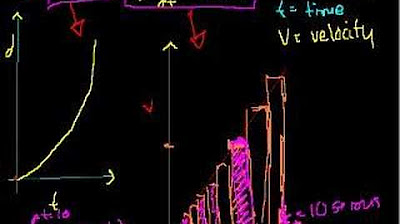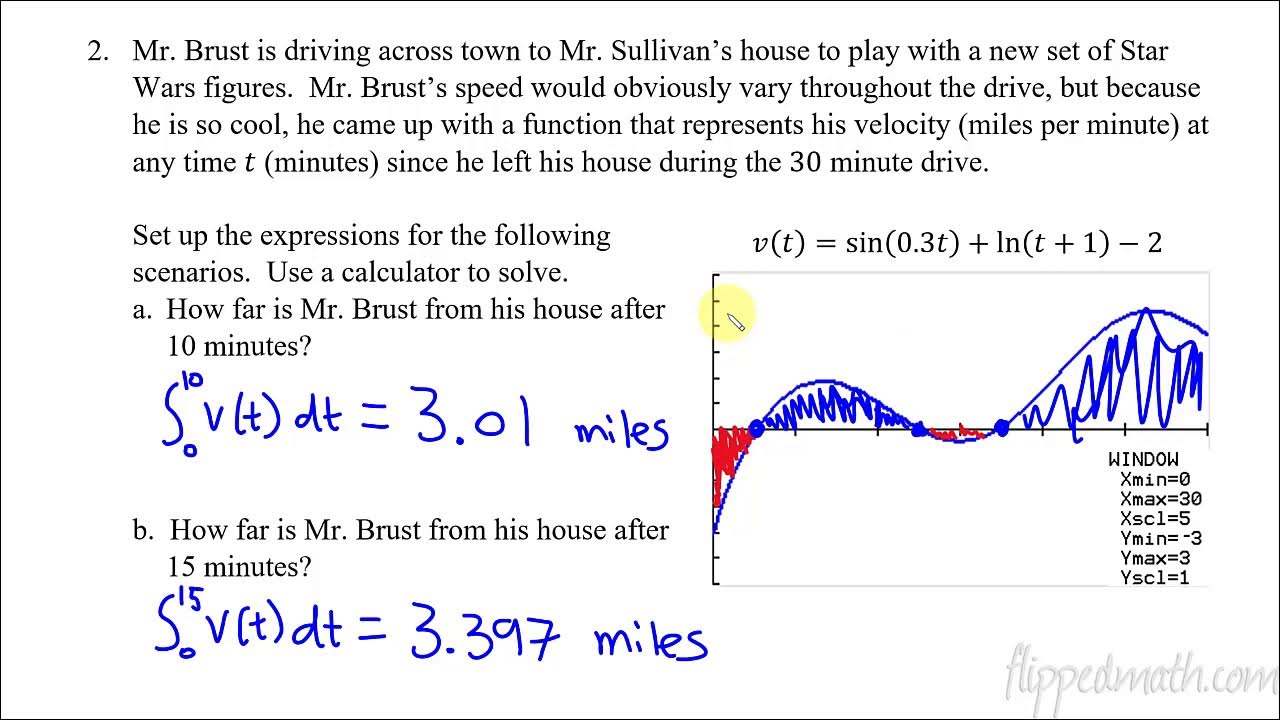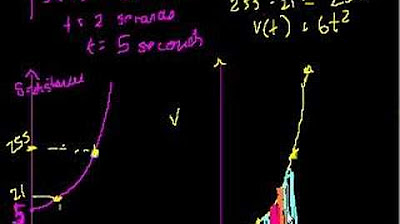2011 Calculus AB Free Response #1 parts b c d | AP Calculus AB | Khan Academy
TLDRThe video script discusses the concept of average velocity, emphasizing its relationship with distance and time. It explains that average velocity is the total distance traveled divided by the time taken, and without a specific position function, one must utilize the velocity function to calculate the distance. The method involves approximating the area under the velocity curve from time 0 to 6 as the total distance traveled. The script highlights the use of a calculator, specifically the TI-85, to evaluate the definite integral of the velocity function over the given time interval. The process is clear and informative, providing a practical approach to understanding and calculating average velocity in physics.
Takeaways
- 📝 The concept of average velocity is introduced as the total distance traveled divided by the time taken.
- 🔢 To calculate average velocity, use the formula: average velocity = distance / time.
- 📈 The distance traveled can be determined by calculating the area under the velocity-time graph.
- 🏷️ The symbol 'd' or 's' is sometimes used to represent distance or displacement in calculations.
- 🌟 For small time intervals, the product of time and the constant velocity during that interval approximates the distance traveled.
- 🧩 The total distance over a period is the sum of the distances of all small time intervals, represented by the area under the curve.
- 📊 The definite integral of the velocity function 'v(t)' from 0 to 6 represents the total distance traveled from time 0 to time 6.
- 📱 The use of calculators, such as the TI-85, is allowed and recommended for evaluating complex definite integrals.
- 🛠️ The process of finding the average velocity involves first determining the distance traveled and then dividing by the total time of travel (in this case, 6 units).
- 📱 The script briefly mentions navigating to the catalog function on the TI-85 calculator to evaluate definite integrals.
Q & A
What is the definition of average velocity?
-Average velocity is defined as the total distance traveled divided by the total time taken.
How can you represent distance or displacement in mathematical terms?
-You can represent distance or displacement with the variable 'd' or 's' in mathematical terms.
What is the relationship between distance, average velocity, and time?
-The relationship between distance (d), average velocity (v), and time (t) is given by the formula: d = v * t.
Why is the position function not explicitly given in this problem?
-The position function is not given because the focus is on finding the average velocity using the velocity function, which is provided.
How can you estimate the distance traveled during a small time interval?
-You can estimate the distance traveled during a small time interval by multiplying the time by the constant velocity over that interval, which gives you the area of a small column representing the distance traveled.
What is the method to calculate the total distance traveled between time 0 and time 6?
-The total distance traveled between time 0 and time 6 is calculated using the definite integral of the velocity function (v(t)) from 0 to 6.
How do you find the average velocity given the total distance and elapsed time?
-To find the average velocity, divide the total distance (found from the definite integral of the velocity function) by the elapsed time.
What tool is mentioned for evaluating the definite integral in this problem?
-A calculator, specifically the TI-85, is mentioned as a tool for evaluating the definite integral in this problem.
What is the purpose of the catalog function on the TI-85 calculator?
-The catalog function on the TI-85 calculator provides a list of different mathematical functions available for use, including those for evaluating definite integrals.
What is the change in time (delta t) in this problem?
-The change in time (delta t) in this problem is 6, as the time interval considered is from 0 to 6.
How does the process of finding the average velocity involve the velocity function?
-The process involves first finding the total distance traveled by calculating the area under the velocity function curve from time 0 to 6 using definite integration, and then dividing that distance by the elapsed time to find the average velocity.
Outlines
📝 Calculation of Average Velocity
The paragraph introduces the concept of average velocity and explains its relationship with distance and time. It emphasizes that average velocity is the total distance traveled divided by the total time taken. The explanation includes a discussion on how to calculate the distance when the position function is not given by using the velocity function and the concept of integration. The process of finding the area under the curve from time 0 to 6 is described as a method to determine the total distance traveled. The paragraph also mentions the use of calculators, specifically the TI-85, to evaluate the definite integral which represents the distance in this context.
Mindmap
Keywords
💡average velocity
💡distance
💡displacement
💡velocity function
💡definite integral
💡time interval
💡area under the curve
💡constant velocity
💡calculator
💡catalog
💡position function
Highlights
Introduction to the concept of average velocity.
Explanation that distance equals average velocity times time.
Clarification on the absence of an explicit position function.
Use of velocity function to infer distance traveled.
Description of the method to calculate distance as the area under the curve.
Application of definite integral to represent the total distance.
Mention of the use of calculators for evaluating integrals.
Procedure to find the distance traveled between time 0 and 6.
Reference to the TI-85 calculator and its functions.
Explanation of navigating the TI-85 calculator's catalog.
Use of the definite integral function on the calculator.
The process of dividing the calculated distance by time to find average velocity.
Emphasis on the importance of time interval in the calculation.
General drawing of the velocity function for illustrative purposes.
Transcripts
Browse More Related Video

Definite integrals (part II)

Area under rate function gives the net change | AP Calculus AB | Khan Academy

Calculus AB/BC – 8.2 Connecting Position, Velocity, and Acceleration of Functions Using Integrals

GCSE Physics - Velocity Time Graphs #54

Definite Integrals (area under a curve) (part III)

Average velocity for constant acceleration | One-dimensional motion | Physics | Khan Academy
5.0 / 5 (0 votes)
Thanks for rating: